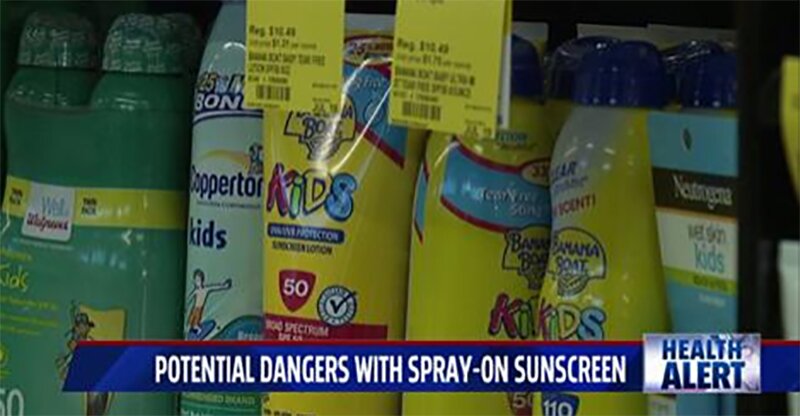
Spray sunscreeens are popular, especially for use on children. But our safety experts are particularly concerned about the possibility that people might accidentally breathe in the ingredients, a risk that’s greatest in children, who—as any parent knows—are more likely to squirm around when they’re being sprayed.
The FDA announced last month that it’s investigating the potential risks of spray sunscreens, and until the results are in, spray sunscreens are out.
The FDA is studying whether some of the ingredients the kids are swallowing are harmful. On the back of most spray suncreens you can find a warning that says keep out of reach of children and to get medical help if it is swallowed or inhaled, because it can be harmful or fatal.
The Environmental Working Group offers up an annual guide to sunscreens, which not only helps people identify products that have harmful ingredients, but also takes aim at marketing gimmicks. This year’s assessment found that 80 percent of sunscreens evaluated are either ineffective or potentially harmful.
“We don’t recommend that consumers use these products,” explains Environmental Working Group’s Senior Scientist Dave Andrews. “There are inhalation concerns as you are breathing in these sunscreen ingredients when you apply them, and it’s difficult to get an adequate coating on your skin to even verify that people are applying an adequate amount.” Manhattan dermatologist Dr. Macrene Alexiades-Armenakas agrees with the concerns: “[These types of sunscreens] are manufactured with phthalates, which is worrisome. They can get into your lungs.”
There is also the issue of certain types of ingredients posing increased risk in aerosol form. While mineral blockers are often considered a good alternative to chemical sunscreens, it turns out that’s not the case with spray sunscreens. If your spray sunscreen contains titanium dioxide, don’t use it. In a 2006 report from the International Agency for Research on Carcinogens, found that titanium dioxide is “possibly carcinogenic to humans when inhaled which the EWG explores in their report on nanoparticles: “The lungs have difficulty clearing small particles, and the particles may pass from the lungs into the bloodstream. Insoluble nanoparticles that penetrate skin or lung tissue can cause extensive organ damage.” It’s all incredibly alarming. With all these concerns, and tests ongoing, maybe reaching for the lotion, even though it takes a little bit longer, might be the way to go this summer.
Sources
https://www.yahoo.com/beauty/the-alarming-reasons-you-shouldnt-use-spray-124932543328.html
http://www.consumerreports.org/cro/news/2011/07/don-t-spray-sunscreens-on-kids-at-least-for-now/index.htm
http://www.consumerreports.org/cro/news/2011/07/don-t-spray-sunscreens-on-kids-at-least-for-now/index.htm
All content on this Web site, including medical opinion and any other health-related information, is for informational purposes only and should not be considered to be a specific diagnosis or treatment plan for any individual situation. Use of this site and the information contained herein does not create a doctor-patient relationship. Always seek the direct advice of your own doctor in connection with any questions or issues you may have regarding your own health or the health of others.

